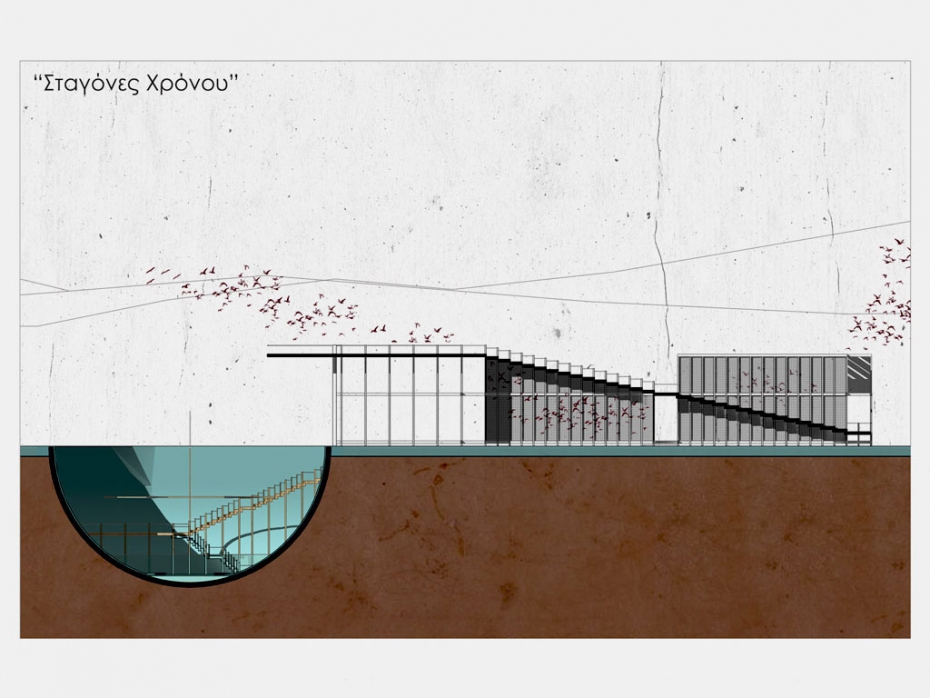Subtitle: Reformation plan of the area surrounding the Salt works canal of Mesolonghi
Brief:
The aim of my design thesis is to design a natural “theme park” in the area surrounding the canal of the Salt works that will make the visitor travel in time (past-present-future. A journey that will make him understand why the sea lake constitutes a tank of cultural memory and heritage and how water has shaped the city’s identity.
Supporting text:
Μesolonghi: “messo”+ “langi” → the place amid lakes
Mesolonghi is a typical example of a city born from the water. From the past until the present, the city has been extricably linked to the element of water, as it is surrounded by the “sea lake of Mesolonghi” from the east, west and south side. It is water that has formed every aspect of this city; its culture, its history, its architecture. However, during the 19th century the earthworks and the desiccation of the sea lake as well as the constant expansion of the city towards the water have proved disastrous not only for the city’s’ ecosystem but also for its urban and spatial organization and planning.
The only part of wetland that comes in direct contact with the urban tissue and brings water straight into the city is a canal called “Canal of the Salt works”. It was created in the past in order to transport water with high salinity levels from the east (“Kleisova”) towards the west where the saltpans were created. Nowadays, its surrounding area has been abandoned and as a result instead of the canal being the artery of the city, it is a neglected and forgotten part of it.
The aim of my thesis is to suggest an urban reformation plan of the canal that will reactivate the role of water in the city as well as redefine the relationship between the locals and the liquid element. The basic ideas that led to the final design were two:
1st : the improvement of the quality of sea water that is transferred from the east to the west and therefore the amelioration of the condition of the ecosystem. This is obtained with the creation of a new canal that runs alongside the preexisting canal. The new canal is used to transfer clean filtered water into the preexisting canal as well as to create urban water squares by flooding empty spaces of the city that used to be covered with water in the past.
2nd: the creation of a “theme park” that will make the visitor travel in time in order to realize the important role that water has played in the development of this city throughout the years.
The “theme park” is divided into three zones, each of which has its own denomination:
A: “Water-Earth-Sky: the sea lake creating life”
The first zone on the east demonstrates the way in which water in collaboration with the sky and the earth give birth to the flora and fauna of the sea lake. This relationship between water-earth and sky is indicated throughout the promenade through a variety of scales. The promenade begins with the descent of the visitor into an underwater aquarium and is continued with his entrance into a hemisphere where the new canal is born. The hemisphere covered with reads infiltrates the water that runs through them and supplies the new canal with clean water which subsequently begins to flow underground towards the city. The promenade through the first zone ends with the passage through a wooden structure, inspired by the traditional “pelades” which functions as a centre of protection and research of the sea lake birds,
B: “Water and the City: from the past to the present”
The second zone is the one that takes the visitor into a journey from the past to the present reminding him how water constantly changes the life of the city. Firstly, beneath the northern end of the street Mayer the creation of an underground linear history museum is proposed. After walking towards the north the passerby reaches the final part of the museum which ceases to be linear and acquires the form of an introverted building that surrounds a shallow saltwater pool where traditional fishing boats are exhibited. The building is called “Museum of the sea lake”. A ramp that surrounds the pool leads the visitor into the different exhibition rooms ascending him finally to a higher platform from where he can see the new canal joining the old one.
C: “Water regaining its role in the city: a vision for the future”
The last zone on the west side is the ending of the promenade and the journey in time. It is a vision of how the city could become in the future if the sea lake began to corrode the land of the city and therefore regain its ground. The ground and water levels defer so as to create a landscape that constantly changes through the seasons revealing each time different materials, such as salt, mud, pebbles etc. It is an attempt to answer the question: “What if instead of the city expanding towards the sea lake, the sea lake expanded into the city?”













